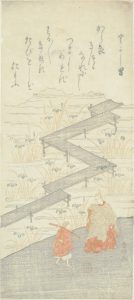
Created by Raymond, Julia, Michelle H, Risha, Grace.
Poetic episode cited
Tales of Ise, Episode 9, translated by Helen Craig McCullough.
Once a certain man decided that it as useless for him to remain in the capital. With one or two old friends, he set out toward the east in search of a province in which to settle. Since none of the party knew the way, they blundered ahead as best the could, until in time they arrived at a place called Yatsuhashi in Mikawa Province. (It was a spot where the waters of a river branched into eight channels, each with a bridge, and thus it had come to be called Yatsuhashi—“Eight Bridges.”) Dismounting to sit under a tree near this marshy area, they ate a meal of parched rice. Someone glanced at the clumps of irises that were blooming luxuriantly in the swamp. “Compose a poem on the subject, ‘A Traveler’s Sentiments,’ beginning each line with a syllable from the word ‘iris’ [kakitsubata],” he said. The man recited,
Karagoromo I have a beloved wife
Kitsutsu narenishi Familiar as the skirt
Tsuma shi areba Of a well-worn rove,
Harubaru kinuru And so this distant journeying
Tabi o shi zo omou Fills my heard with grief.
They all wept onto their dried rice until it swelled with the moisture.
References
Conder, J. (1912). Chapter 8. Garden Bridges. In Landscape Gardening in Japan. essay,
Shuyeisha, Japan.
Eight-Platform bridge (Yatsuhashi), from THE “Tale of Ise (Ise Monogatari)”. The Art Institute of
Chicago. (n.d.). Retrieved September 20, 2021, from
https://www.artic.edu/artworks/19977/eight-platform-bridge-yatsuhashi-from-the-tale-of-is
e-ise-monogatari.
Greve, G. (2005, June 3). WKD – Kakitsubata Summer Iris. WKD – kakitsubata Summer Iris.
Retrieved from https://happyhaiku.blogspot.com/2005/06/summer-iris.html.
Irises (Kakitsubata) by Ogata Korin. Irises, main. (n.d.). Retrieved from
http://www.columbia.edu/itc/ealac/schirokauer/iris/.
Kuitert, W. (2014). “Japanese Art, Aesthetics, and a European Discourse: Unraveling
Sharawadgi.” Japan Review, 27, 77–101. http://www.jstor.org/stable/23849571
McCullough, H. C. (1990). “Tales of Ise.” In Classical Japanese Prose: An Anthology (pp.
74–75). essay, Stanford University Press.
Ōtani, S. (2021). Chapter 7: The Structure of the Noh Play Kakitsubata: Zenchiku’s Method. In
J. S. Mostow, T. Yamamoto, & K. Hanlon (Eds.), An Ise monogatari Reader: Contexts
and receptions (p. 151). essay, Brill.
Takagi, N. (2020, August 29). ‘Tales of ISE’: The book where Japanese literature found beauty.
Nikkei Asia. Retrieved from
https://asia.nikkei.com/Life-Arts/Arts/Tales-of-Ise-the-book-where-Japanese-literature-fou
nd-beauty.
yatsuhashi 八橋. 渥美財団. (2001). Retrieved from
http://www.aisf.or.jp/~jaanus/deta/y/yatsuhashi.htm.
うるはしの意味. 古文辞書 – Weblio古語辞典. (n.d.). Retrieved September 19, 2021, from
https://kobun.weblio.jp/content/%E3%81%86%E3%82%8B%E3%81%AF%E3%81%97.
